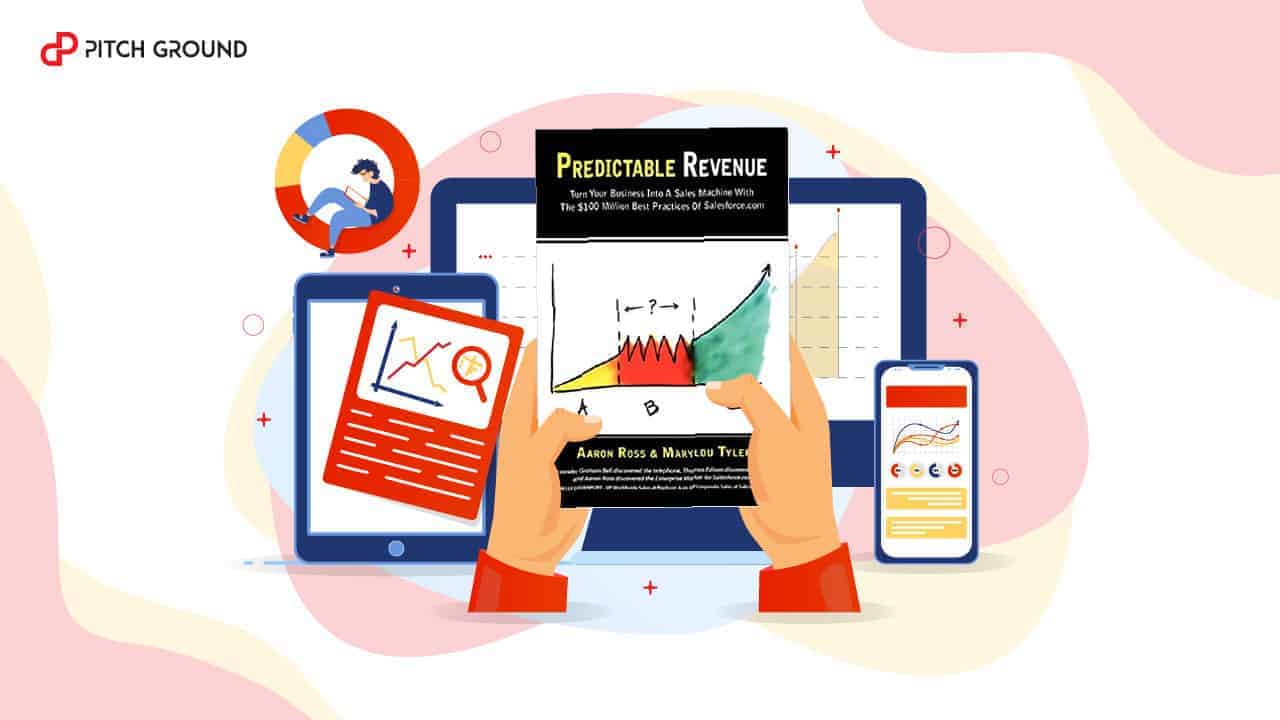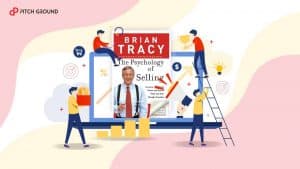Predictable Revenue Summary: Turn Your Business Into A Sales Machine With The $100 Million Best Practices Of salesforce.com is a book by Aaron Ross that teaches you how to create a systematic and disciplined sales process.
Aaron discusses his experience at Salesforce.com starting a new group that used an innovative outbound prospecting approach (involving no cold calls) to create new leads.
Aaron’s group came up with several important breakthroughs which enabled them to add over $100m in incremental recurring revenues over a few short years.
He says that “Building a highly-productive, modern sales organization requires increasing specialization.” Specialization in the prospecting process allows sales reps to improve their craft and build out a skill essential to their future success.
Let’s walk through the summary of this book and understand how to generate predictable and scalable revenue. Take a look:
Introduction
Ross says that Great companies know the sale is just the first step in an ongoing process of making customers successful over the years.
Aaron Ross tells us that creating a predictable revenue process takes three things:
Predictable lead generation- It includes identifying the desired leads that you want to target and tracking the actual conversions.
A dedicated sales development team that connects marketing and sales specialize people for lead generation and giving demos and closing.
Consistent sales systems- Consistency is the key. Just document your entire process so every salesperson follows the same process and there are no confusions.
Before we move ahead, the main question that strikes most entrepreneurs or established leaders is, “Do you need an outbound sales team?” If you need some direction, ask yourself these two questions:
1 Are people involved in the process of finding new clients? Like will they bring referrals? Ross says “If it’s not intended to be repeatable, it’s not worth doing.”
2 Are your customers worth more than a certain amount to you?
Predictable Revenue aka COLD CALLING 2.0
Cold Calling 2.0 means prospecting into cold accounts to generate new business without using any cold calls.
I define a cold call as calling someone who doesn’t know you and who isn’t expecting your call. No one enjoys this – neither the caller nor the person being called, right?
Traditional cold calling is dead because it often means starting a sales conversation with the wrong person. Ross realized early in his sales career that the main problem of prospecting or cold calling is spending most of the time searching for the right person, not qualifying or selling to them.
So instead of continuing to try something that didn’t work, he tried getting referrals to the right person in the company. Ross feels that With a reference, the conversation feels a little bit more authentic and you have a valid reason to contact the prospect.”
His strategy, what he calls Cold Calling 2.0, focuses on not making the initial contact about the sale at all.
“Trying to sell at this stage will wreck the conversion rate of these emails,” says Aaron. “It’s like going for coffee with someone on your first date, and you are leaning in for the kiss before you have said hello.”
“The [outbound sales team] has a single mission: to generate…new qualified sales opportunities from cold companies (ones that have no activity or interest) and passing these qualified opportunities to quota-carrying salespeople to close,”Aaron says that implementing the Cold Calling 2.0 system, you should have at least one person that is 100% dedicated to prospecting.
Initially, you can start part-time, but it will be hard to get significant results until you have someone committed to it. Take a look at how to do cold calling 2.0 :
Aaron says that implementing the Cold Calling 2.0 system, you should have at least one person that is 100% dedicated to prospecting. Initially, you can start part-time, but it will be hard to get significant results until you have someone committed to it. Take a look at how to do cold calling 2.0 :
- Ideal Customer Profile- The first step is being clear on your ideal customer profile. Be clear about the companies or industries you want to sell to, and the positions of the people in those companies responsible for buying what you sell.
- Build your list- Then eventually, build a list of contacts that match your profile using data service.
- Run outbound email campaigns- A crucial part of Cold Calling 2.0 is knowing how to use outbound emails effectively. Lost found emails don’t work as you are not selling something. Instead of sending a lost type of email, asking someone to direct you to the right person about your offering, it’s preferable to send a referral mail saying so-and-so referred you. This way, it’s not a cold-email anymore but rather a referral.
- Sell the Dream- Make discoverers call with the target prospect and determine the mutual fit and interest. Make sure to stay focused on the prospect’s business and don’t start selling yours at this point. Just help them connect their needs to your solutions. Make them believe in the dream, and they’ll automatically do the selling for you.
- Pass the Baton- Once you’ve determined that there are a good fit and an opportunity, pass the baton to an Account Executive or the sales closers for the close.
Specializing in four core sales roles
For Cold Calling 2.0 to get executed properly, the authors suggest that the sales team should be divided into specialized functions. One of the biggest productivity killers in sales is giving a sales rep more than one core sales responsibility.
The reason why big companies have amazingly phenomenal sales organization is that they have specialization of roles and segmented responsibilities. Specialize your sales teams as follows:
- Qualifiers- This includes everything concerned with Sales Development – inbound and outbound. It consists of the professionals who have the first contacts with the leads. They give the first response to leads generated by marketing actions or qualify new sales opportunities from cold accounts. Then they will pass the leads to account executives to close.
- Closers- Commonly called “account executives,” these are quota-carrying reps who close deals after qualifying. Though they stay in contact with the new customers, they are not responsible for client deployment. Their main task is to convert opportunities into new revenue for the company; thereby achieving their revenue goals.
- Farmers- These include Customer Success and Account Managers. These people are responsible for client deployment, expanding the customer account with the company, and their renewals. They are ones responsible for keeping customers happy.
When’s the last time you’ve met a salesperson that excels at everything? Prospecting, qualifying, problem-solving, negotiating, closing, and account management, it is not the work of a salesperson.
One of the biggest productivity killers is lumping together a mix of different responsibilities into one general “sales” role. It creates significant inefficiencies:
- Unclear Metrics: It’s harder to break out and keep track of key metrics (inbound leads, qualification and conversion rates, customer success rates) if all the functions are lumped into single areas. Better metrics are only possible if you assign different roles, which makes it easier to break out different steps in your processes.
- Less Visibility Into Problems: When problem creep, and things are not working, lumped responsibilities make it difficult to get what’s happening and make it more challenging to isolate and hold a particular person accountable to fix the issues.
- Lack of Focus- One person doing all the tasks successfully, is not feasible. Even if the salesperson does do some prospecting successfully, they’ll not be able to carry it out sustainably. They already juggle with a lot of responsibilities. Loading salespeople with more will only reduce their ability to get things done.
- Harder to Develop Talent- Focus on your salespeople to allow them to become experts in their area — at inbound qualification, closing, prospecting, or farming.
- Expensive- Experienced salespeople hate to prospect, and its a fact. Moreover, it is costly for the company to employ their highest-cost people (account executives/closers), and making them do the lowest cost work of prospecting. It does not make sense at all.
You need to have special people for specific roles. By specializing sales roles into “qualifiers,” closers” and “farmers,” each team member can focus on what he or she is best at and become experts.
Moreover, the efforts of your team get consistent and become predictable, thereby making it more comfortable in the long run.
When to Specialize?
The next question to strike is that when is the right time to specialize. Ross says that he frequently hears “We’re too small to specialize yet.” But, he thinks it is always “sooner than you think,” even if you have a handful of Account Executives.
To begin the process, all you need is two people. For example, The second person you hire, after a salesperson who can close, should be a sales rep who is dedicated just to generating leads for your first closer.
He says he uses the 80/20 rule of thumb. When your reps, as a group, are spending more than 20% of their time on a secondary function, break out that function into a new role.
For example, the person whose main task is to generate outbound leads starts spending more than 20% of their time qualifying inbound leads; it’s high time that you should hire a dedicated and specialized rep just for responding to inbound leads.
THE ONION LAYERS
Aaron has described the stages of your sales process that helps in building the relationship with your potential customers as the layers of an onion. It is all about how to lead a prospect through to becoming a customer.
Ross says that People lack patience in this world. Salespeople need to relax and stop trying to go for the close so fast because customers want to get to know you in small steps. And they want to feel that they are in control of that process.
Ross says to consider your customers as a squirrel. Your job is to put out tempting morsels (i.e., free trials, ebooks) one after another to get them to take the next step forward.
It is similar to peeling back the layers of an onion. So you need to practice patience and take baby steps because times have changed.
Gone are the days, when buyers had limited access to information. These buyers can do more research on their own before they even interact with a company.
So, it’s better to let them decide how and when to move forward. Just set the progressive layers of the onion to receive sales. However, the layers are mutual. Get to know your prospects as they get to know you.
Still, before giving something free to the customer, you need to make them want that and understand where it fits in their buying process.
Lead Generation (“Seeds, Nets and Spears”)
Every business needs predictable and scalable revenue, and high-quality sales lead. Seeds, nets, and spears can help your outbound prospecting team capitalize on different types of opportunities.
According to Aaron, businesses need a steady stream of three types of leads to achieve predictable and scalable revenue:
1. Seeds, or leads that come from word-of-mouth marketing- They usually come from customer recommendations and take a lot of time to cultivate. But once they get going, they end up becoming your best customers. However, you need to very patient as they take a lot of effort and time to grow.
2. Nets, or leads that come from inbound marketing- These are marketing programs that help you to attract leads- like SEO, social media, blogging, webinars, advertising, etc.
3. Spears, or leads that your sales reps bring in through lists and outbound prospecting. – These leads are the opposite of Nets—they are targeted outbound efforts. They are tiny in number and can help you get predictable results.
These three types of sales leads go along with each other, therefore to succeed and attain predictable revenue you need all of them.
Inbound Marketing Methods
Some of the tools you have to advance to generate leads more efficiently. Each of these methods not only creates new prospects but also helps to nurture the existing ones. Take a look:
- Referrals- This is one of the most effective channels out there. Both offline and online references through positive testimonials.
- Free Trials Tools: It includes any free samples or trial periods for your product, free training videos, etc.
- Organic Search: Comes from the quality content and Search Engine Optimisation, i.e., strategic use of keywords that would attract the customer to your page. SEO also helps to fetch good rankings on Google.
- Blog: days it is considered as an essential means of communication in which you can build a direct link with your reader. It allows you to share all the vital information that is relevant to your business. It also helps to catch the attention of the customer to the company.
- Email marketing- It is still one of the essential marketing technique to develop new leads and nurture old ones. It is the best official way to let the customer know of your happenings, be it about promoting your products/services, sharing your blog posts or to inviting people to events or webinars, it helps to build and strengthen your relationship with the public.
- Webinars- A great way to keep engaging your prospect. You can hold webinars with the customers and presenters and help them with useful information. This way you can modify and maintain the solutions to the needs of those who stay connected with you via these strategic moments. It helps customers to establish trust in the company.
- Affiliate Marketing: Bloggers with large audiences, whose interests and values align with yours are no less than a blessing these days. You can go for partnership with them and promote your product/service, thereby tapping an entirely new audience. You can give them a pay-per-lead or percentage-of-revenue basis.
- Social Media- It is again a great tool to promote your product.
THE GREATEST BOTTLENECK
A breakthrough Aaron had at Salesforce.com was finding that the biggest bottleneck in prospecting isn’t selling the decision maker – it’s finding them in the first place.
Often, the final decision maker is not the first person you’ve talked to, which is why it’s essential to winning over internal champions and coaches first.
You can also coach up with your advocates, who can help you get into the organization. It is true that the buying process is in the hands of the prospect; you can anyway control the tactics which can accelerate the sales process.
The 3-Hour-and-15-Minute Sales Process
Ross believes that there is a simple recipe for creating your sales process.
You should take 15 minutes to qualify or disqualify an opportunity, one hour to understand the decision process and who are the key people, and two hours to create a joint vision that will pull them forward in the process, i.e., how your company can help the prospect to solve his challenges.
With this duration of time, you need to introspect yourself with a few questions:
- The most important question is “Why”?- Experienced and good salespeople know how to use this question effectively. A lot of times it happens that the prospects have not even thought about the challenges and the root cause of their problems, and these salespeople help them identifying and reach these causes and what kind of solutions are effective enough to solve their problems. Questions that start with “why” help you search these answers and lets you get on the process of selling.
- When calling Anyone my favorite question to open a conversation: “Did I catch you at a bad time?” It’s friendly and gives the person a chance to collect their thoughts. This way you’re asking for permission to chat and your luck triggers, and they do have a few minutes, it always leads into a great chat. And if it truly is a bad time, you don’t want to talk with them at that point anyway, and ask “…when is a better time?”
Prospects Should Earn Proposals
In his book, Aaron writes, “If you’re not winning at least 50% of the proposals you’re giving out, you’re too easy. For you to generate predictable revenue, you need to have predictable leads.
If you give out e proposals too soon, the prospect doesn’t value it or your time, and you lose the lead. Let them earn the proposal. Don’t give it to them until they want it.
Leadership
This final section of the book, explains how to set up your entire team for sales success. Some visible changes in the mindset of the executives are needed, to turn a business into a source of predictable revenue.
One of the most common mistakes made by CEOs and sales VPs are not being up-to-date and not educating themselves on lead generation. Start specializing sales roles and get coaching on how to hire, train and incent.
Aaron offers a variety of advice to help executives put the Predictable Revenue into action:
Focus on the customer rather than the product: Executives should spend 25% of their time together with “customer-in” customers, to know what you do for them, rather than how you can do.
Constant follow-up: Choose 3 to 5 sales indicators and track them. Measure their review week by week
Focus on After Sales: Hold the hands of your customers and give them love. Be present for them even after purchase. Invest in customer success.
How To Hire and Develop Good Sellers
The funda here is to treat your sales team as your customers. To be an effective sales manager, hire smart people who are organized and have good learning power. Building their trust is essential.
Get their input on decisions early and often, build a relationship of trust, ask for feedback, and ensure that they succeed. If you work for the success of your team, they will work for your success and the success of the company.
Ross says that At Salesforce.com they created “Salesforce University,” a weekly meeting for internal training.
Conclusion
It is a fantastic book in which Aaron Ross shares his extensive experience in the high tech selling world. His insights are viable and helpful for any industry.
It explains in detail as to how the sales process works in today’s time and is a must-read for every Entrepreneur, any sales professionals, and businessmen.
Also make sure to read Summary of Pitch Anything by Oren Klaff



